|
1.
CENTRAL/ WEST AFRICA
Slowing demand creates buyers¡¯ market
Business continued to slow, and demand has fallen further
from the previous fortnight. Log export volumes are
currently much lower than normal, up to one-third less
than would be expected for this time of year. Buying for
India is taking place, but volumes are reduced and tough
negotiations on prices have led to some concessions. As
previously noted, West African producers have made quite
severe reductions in logging volumes and areas, laying off
workers and generally taking all sensible steps to hold
production down to the current demand.
Logging for sawmills has also become more selective for
particular species and sawn lumber production has been
kept at moderate levels while matching as closely as
possible the expected demand for premium timbers.
European buyers are very cautious since they have
adequate levels of stock overall and made lower offers for
purchases or are waiting for prices to fall. Many believe
that time is on their side in what is now very much a
buyers¡¯ market.
As noted, market conditions in all areas are very difficult
and there is no sign of any upturn. While the steep costs of
fuel may not yet have worked through the system, there is
little doubt that producers will face substantial increases in
fuel costs, especially in transportation of all products.
Higher bunker surcharges on sea freight costs also will
impact buyers landed costs. This may mean that when
many months have passed, the current lower log and
lumber prices will in retrospect look more attractive than
buyers now believe.
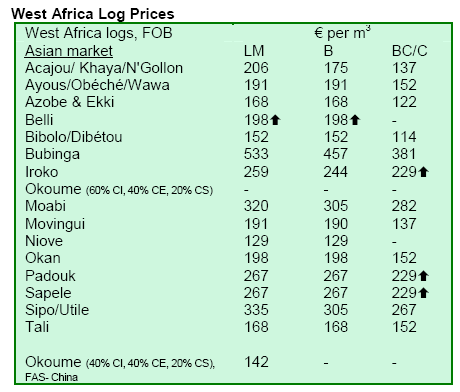
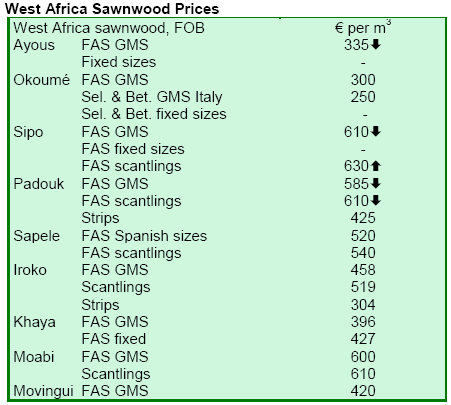
2. GHANA
Ghana launches GIFEX 2008
Various news sources in Ghana reported on the launch of
the ¡®The 12th Ghana International Furniture and
Woodworking Industry Exhibition (GIFEX) 2008¡¯, which
will be held from 17¡ª26 October 2008 in Accra, Ghana.
The event will focus on the theme, ¡®100 Years of Forestry
in Ghana: Working Partnership for Sustainable
Development¡¯. GIFEX is an annual event where the
furniture and woodworking industry from within and
outside Ghana exhibits new products and advances in the
trade to consumers and the general public.
In a speech read on his behalf at the launch, the Chief
Executive of the Forestry Commission, Professor Nii
Ashie Kotey, stated that the forestry industry accounted
for about 4% of Ghana¡¯s GDP and 11% of export
earnings. He said over the last 20 years, export revenues in
the sector had risen to about USD250 million in 2007, up
from USD44 million in 1986 and the bulk of this revenue
came from secondary wood products such as lumber,
veneer and plywood. However, he said, average export
revenues from the sector over the last five years had
stabilized at about USD212 million. He said the largest
producer of logs for the industry has been the Western
Region of Ghana, where about 35% of logs were produced
last year.
Professor Kotey added that GIFEX 2008 would be
relevant to the forestry sector policy of promoting viable
and efficient forest-based industries to satisfy domestic
and international demand for competitively priced valueadded
products. He said that strategic innovations in the
wood industry were required to help Ghana remain
competitive in global markets and for the promotion of
tertiary wood processing in the country. It was expected
that through GIFEX 2008, there would be a general
improvement in the production of quality wood products,
promotion and increased utilization of lesser-used timber
species as well as development of new technologies in the
industry to enhance industry efficiency, productivity and
competitiveness.
TIDD reports sharp improvement in Q1 plywood prices
According to the Timber Industry Development Board
(TIDD) contract report, there has been a sharp
improvement in prices of plywood during the first quarter
of 2008. Buyers of plywood in West African countries,
especially Nigeria, have been paying between USD20/m³
and USD30/m³ more than the TIDD minimum Guiding
Selling Prices (GSP). The price paid depends on the
thickness of plywood being demanded. This development
has helped push up prices of plywood and rotary veneer to
US markets, which were slightly below the minimum
GSP. Though prices of plywood and rotary veneer to the
US are still low when compared to those in ECOWAS and
European markets, they have improved by an average of
USD15/m³ and USD25/m³ respectively above the
minimum GSP. The only exception to this trend is celtis
rotary veneer, which is still at the GSP of USD384/m³.
West African countries have been the major consuming
markets of Ghana¡¯s plywood exports, with Nigeria topping
the list. Currently, about 70% of Ghana¡¯s plywood exports
is absorbed by West African markets. Export prices of
niangon boules, which were down during the third and
fourth quarters of 2007, have shown signs of improvement
during the quarter under review. Contracts submitted
registered higher prices of between EUR510/m³ and
EUR540/m³, up from the current GSP of EUR500/m³.
Prices of air-dried wawa, which were stable during the last
quarter of 2007 and hovering around the GSP of
EUR255/m³, rose by an average of EUR10/m³ during the
quarter under review.
Within the same period, prices of traditional species
improved as they did during the previous quarter. Prices
of khaya ivorensis, sapele, makore and utile particularly
improved on average EUR15/m³. Prices of odum did not
improve as during the previous quarter. Exporters
therefore found it difficult to achieve the minimum GSP of
EUR715/m³ for KD Lumber. For the first time, about
45.5m³ of semi-powdered mahogany bark was exported to
China at a price of USD90/m³. The product was contracted
by Kugyampy Limited of Accra and Qingdao Songlin
Wire Industry Company Limited of China.
Of the few contracts submitted for approval during the last
month of the quarter under review, teak log prices
improved on average USD20/m³. It is anticipated that
prices of timber to India would improve during the second
quarter. Generally prices for most of the species in lumber
form were stable during the quarter under review.
Over USD3 million pledged at ITTO meeting in Ghana
The ITTO convened a meeting on the modalities of
organizational thematic programmes and other issues
associated with the entry into force of the International
Tropical Timber Agreement, 2006 (ITTA 2006) in Accra,
Ghana from 9¡ª12 June 2008. In an interview with the
Daily Graphic newspaper, Mr Tabi Agyarko, Principal
Planning Officer at the Ministry of Lands, Forestry and
Mines, said the meeting also assessed the possible impact
of the ITTA, 2006 on the operations of the International
Tropical Timber Council¡¯s subsidiary committees, as well
as addressed the cycle of submission, review and funding
of projects. At the Ghana session, grants worth USD2
million to assist sustainable forest management in Africa
were announced. The first day of the meeting also focused
on Africa¡¯s regional challenges and development
assistance needs.
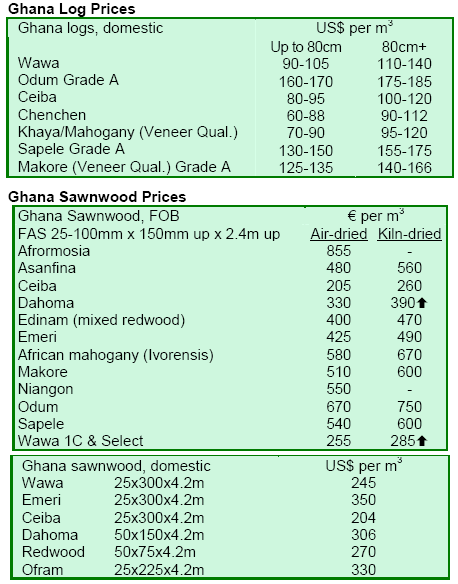
3.
MALAYSIA
New Zealand could help boost Malaysia¡¯s raw material supply
According to The Star, Jim Anderton, New Zealand¡¯s
Agriculture and Forestry Minister, said that Malaysia and
New Zealand could help sustain global timber supply for
production, given the rising international demand for
timber and shortage of raw material supply. Anderton
noted that deforestation in Europe, particularly in Russia,
had reduced quality wood supply and slow growth of
European forests would lead users to seek alternative
sources. He noted that while China supplies Malaysia with
significant amounts of raw material, New Zealand could
also provide raw material to Malaysia. Many timber
manufacturers have sought raw materials from outside
Malaysia lately given the high prices of Sarawak logs.
Wood industry exports up nearly 60%
The Deputy Minister of Plantation Industries and
Commodities, A. Kohilan Pillay, said wood industry
exports in Malaysia during 2007 rose nearly 60% to
RM22.65 billion compared with figures from 10 years
ago. Bernama reported on the Deputy Minister¡¯s remarks,
which were delivered at a Malaysian Timber Industry
Board seminar on incentives for wood-based industries.
Kohilan noted that furniture exports stood at RM6 billion,
and were exported to 160 countries, with the largest
market, the US, receiving about USD2 billion worth of
exports.
Kohilan also said that investments in the wood-based
sector have improved as a result of the growth of the
sector. Investments grew to about RM933.4 million, about
23.1% of total investments in the commodities sector.
Over a third of this amount was from foreign investments
and over half was from domestic investments.
The Malaysian furniture industry was also moving its
export focus from the US to the new members of the EU
in Eastern Europe. According to sources within the
industry, the combined consumption of EU members
could easily replace that of the US in the near future.
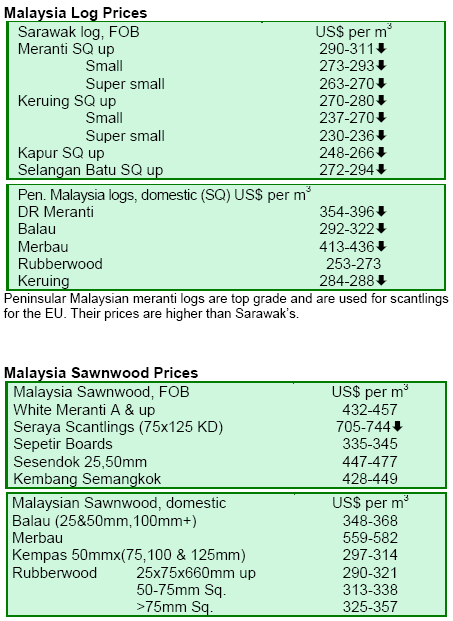
4.
INDONESIA
New trade centers to promote Indonesian products overseas
Antara News said the Indonesian government will launch
eleven new international trade promotion centers (ITPC)
in 2008. In addition to the already established nine ITPC
offices, including in Japan, the US, Australia, the United
Arab Emirates and South Africa, the new centers will help
strengthen the presence of and identify new opportunities
for Indonesian products in international markets. The
ITPCs will be launched in: Shanghai, China; Busan, South
Korea; Chennai, India; San Diego, US; Chicago, US;
Barcelona, Spain; Lagos, Nigeria; Vancouver, Canada;
Jeddah, Saudi Arabia; and Lyon, France. At the same
time, the chairman of the Indonesian Furniture and
Handicraft Producers Association, Ambar Tjahjono, asked
the government to evaluate ITPC activities dedicated to
promoting Indonesian timber products overseas.
In other news, recent hikes of fuel and food prices are
forcing the Indonesian government to sharpen its
international marketing strategy. Steep competition from
China, Malaysia and Vietnam has also made the
positioning of timber products even more critical.
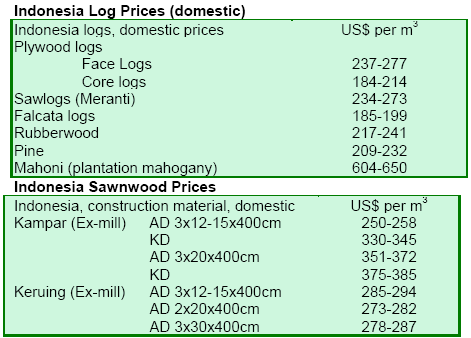
5.
MYANMAR
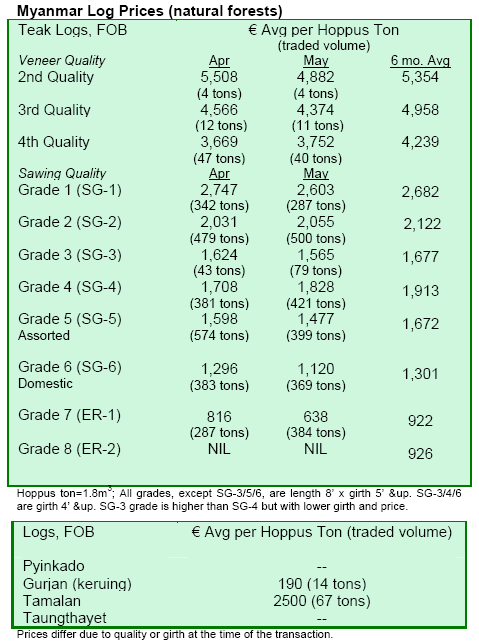
6.
BRAZIL
Credit line will help modernize logging in the Amazon
The new Brazilian Minister of the Environment has plans
to use credit lines for Economic and Social Development
(BNDES) to modernize and increase efficiency of
production activities in the Amazon, said Portal
Moveleiro. The production of timber and vegetable oil
products were identified as priorities under the initiative.
The investments will help modernize the production
process by reducing waste during logging and log
processing, since it is believed only three of every 10 logs
eventually get to market. The requested credit line from
BNDES would be used to update machinery and
equipment to spur innovation in these two areas of
production. The Ministry plans to use public finance to
purchase new machines, conduct worker training programs
and introduce capacity building programs for
entrepreneurs.
The Environment Ministry also announced the creation of
an international voluntary fund for the preservation of the
Amazon, which would be established through a
Presidential Decree. The fund already has USD100 million
in donations from the government of Norway.
IWP chip could help thwart illegal logging
Secom-MT reported that the Web Forest Planet Institute
(IWP), located in Brasilia, has developed a system which
could thwart illegal logging in the State of Mato Grosso.
The software utilizes chips inserted in trees for electronic
monitoring and tracking. The project proposal for using
the chip was sent to the Brazilian Senate as an alternative
method used to control deforestation.
The chip allows users to check whether logged trees or
logs sent to timber companies or sawmills are part of a
forest management project of the state. The new software
is simple and is expected to save costs. The chips inserted
in trees register geographic information and location
coordinates such as the species name, height, diameter,
volume and other information necessary for timber
tracking. The distribution and control of the chips would
be carried out by the State Secretary of the Environment
(SEMA). The company has also developed another kind of
chip to be inserted in timber during transportation.
In order to guarantee the security and reliability of the
system, every operator within the company is identified.
Each operator will have a password and the information is
stored in software and other data collection equipment.
Even if such storage equipment were to be destroyed, the
information would be encrypted within a SEMA database.
Productive Development Policy to boost solidwood and furniture sectors
Portal Moveleiro said a plan of action to boost the
solidwood and furniture sectors of Brazil had been
developed as part of a Productive Development Policy
(PDP). The plan of action was recently presented during
the Meeting on Competitiveness of the Timber and
Furniture Sector during the last week of May in Brasilia, at
the Ministry of Development, Industry and Foreign Trade
(MDIC). The policy¡¯s goals include reaching an average
growth of 15% in domestic sales and 7.5% in exports,
increasing consumption in the domestic market by 30%
and expanding investments in innovation, research and
development to 3% and net sales by 0.5%.
Brazil is responsible for 3.2% of the world timber and
furniture production (USD8.7 billion) and 1% of the
world¡¯s exports (USD100 billion). The sector is composed
mainly by micro and small companies organized as a
¡®local production arrangement¡¯. The main challenges for
the sector are to, inter alia: build the capacity of companies
in local production arrangements; expand exports; enhance
the sustainability of the production chain; disseminate
technical standards to improve product quality; increase
Brazil¡¯s share of furniture in new markets; and promote
domestic access to high quality furniture and competitive
prices. MDIC has also said that in order to achieve the
above mentioned objectives, specific credit lines and
expansion of loans for new businesses and designs, brands
and trade strategies will be used.
Solidwood companies in Mato Grosso continue to face difficulties
Wood product exports from Mato Grosso are growing
each month, although the sector has yet to fully recover
from the crisis experienced over the last two years. Many
mills have closed since IBAMA and the Federal Police
cracked down on illegal activities in the sector. The weak
US dollar and the delay by authorities to grant
management plan authorizations had also negatively
impacted solidwood companies.
According to the International Center of Business of the
Industry Federation of Mato Grosso (FIEMT), exports
increased 13.8% in the first four months of 2008 when
compared to the same period of 2007, with sales rising
USD63.44 million to USD72.18 million during the same
period. The regional lumber industry is also giving
preference to the domestic market to increase profits.
Nevertheless, production costs are still high, with energy
costs and taxes continuing to burden manufacturers.
Currently, the number of mills operating statewide is
lower than three years ago as is the number of jobs.
Companies still in operation are those that invested in
diversified products and focused on value-added products.
In an attempt to boost the sector¡¯s productivity, the
CIPEM, in cooperation with other Brazilian agencies, will
be holding the Promadeira 2008 in Sinop, Northern Mato
Grosso, this August. This will be the largest event of the
tropical forest-based industry in the region and an
opportunity to stimulate new businesses and commercial
contracts.
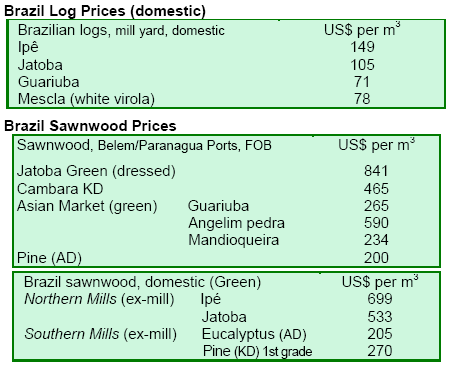
7. PERU
Regional government may control concessions by
2009
The Chief Officer of INRENA, Mr. Jose Luis Camino,
said that in 2009 regional governments may be in control
of concessions that contain rainforests. Camino said that
on 31 December of 2008 at the latest, responsibility for the
concessions would be given to the regional government,
with the exception of those concessions that have bidders
with sound financial and technical resources. Camino said
that INRENA hopes to implement the plan in 2009 with
regional governments and under the supervision of the
Ministry of Agriculture. Part of this plan will involve
strengthening surveillance over vast areas of land.
Camino said that most of the verification in the field and
staff training would be made by parties other than
INRENA. The new plan would give INRENA the right to
collect debts made by concessionaries. Camino also noted
that the evaluation of concessions would not be
undertaken if the concession was over 40,000 hectares, as
the area would require a much larger financial investment
than what was currently available.
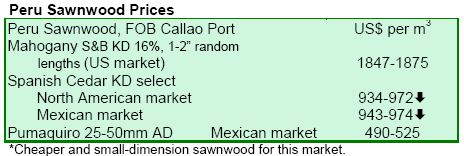
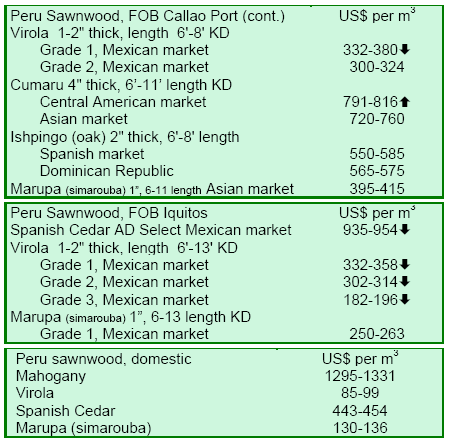
8. BOLIVIA

9.
MEXICO
Plantation timber could diminish Mexico¡¯s dependency
on imports
Commercial forest plantations could be a solution to
diminish Mexico¡¯s dependency on imported timber
products, as well as reduce the productive pressure on
natural forests of the country. The manager of Commercial
Forest Plantation Development of the National Forest
Agency (CONAFOR), Alexander Noguez Hernandez,
said that in 2006, 60% of global wood supply came from
natural forests. Although the remaining 40% were from
plantations, Noguez hoped that by 2040 only 20% would
be from natural forests and 80% would be from
commercial forest plantations.
With Pro Tree, a number of commercial forest projects
will be supported, some with an upwards value of 9,000
pesos per hectare, depending on the species planted. In
2002, when the production of raw materials from
commercial forest plantations began in Mexico and was
supported by the Federal Government, commercial timber
production was 100,000 m³ each year. In 2007, this
number rose to 350,000 m³, and it is hoped that in the
period 2007-2012 this amount will reach 5 million m³.
Currently, national timber production from natural forests
and plantations is around 7 million m³.
10.
GUYANA
Log exports continue to decline while prices rise
Prices for Guyana¡¯s log exports have seen marked
improvements over the past month. However, there has
been a decline in log export volumes over this period.
Roundwood exports, particularly transmission poles, have
increased over previous periods, especially to Trinidad &
Tobago and Dominica. Value-added products, particularly
indoor furniture, have however shown robust improvement
in exports to the European region. The main destination of
these exports was the UK, which has imported more
products from Guyana than in previous periods in 2007.
Recent trends also indicate that exporters are shifting
toward the export of dressed sawn lumber over the
undressed form, a pattern which was the reverse in 2007.
Undressed sawnwood dominated the sawnwood lumber
category in 2007, making up 74% of its total volume. With
more value being added locally, there is some promise of
increases in employment in the domestic economy. The
major markets for sawn lumber remain in the Latin
America/Caribbean region, particularly in Barbados.
LUS to be promoted through results of ITTO project
The utilization of lesser-used wood species in Guyana is
likely to see a major boost following favorable test results,
as outputs of ITTO Project PD 344/05 are completed by
the project¡¯s Executing Agency, the Guyana Forestry
Commission. With hundreds of species in the forest,
Guyana¡¯s species utilization base has been centered on
approximately 40 or so species, with many currently not
harvested, despite being said to have comparable
properties and therefore similar end-use application to
Guyana¡¯s prime commercial species. This ITTO Project
aims to tap into this potential advantage and has a strategy
to provide concrete baseline information, supported by
scientific proof, to boost the utilization of these species
and inform Guyana¡¯s forest sector marketing and
promotion efforts.
This Project, which has been implemented over 2007 ¨C
2008, has seen among the main deliverables detailed tests
by a UK consultancy firm on key lesser-used species in
Guyana¡¯s forests for resistance to abrasion and attack by
Limnoria quadripunctata Holthuis (marine borer). The
tests were a follow-up to a desktop review conducted of
information available on the properties of 15 lesser-used
species. The project sought to increase the utilization of
15 lesser uses species, with robust tests conducted on
identified properties and benchmarking done against ekki
and greenheart, which are both currently used in the UK
for marine application. Specifically, the species are being
targeted for promotion in applications such as marine
construction, heavy structural application and
decking/cladding (for more information see the ITTO¡¯s
Tropical Forest Update Vol 18: No 1).
The results indicate that many of these species performed
the same as the benchmarked species with some even
showing better results. A summary of the results is shown
below and has been taken from the Laboratory Results
Report.
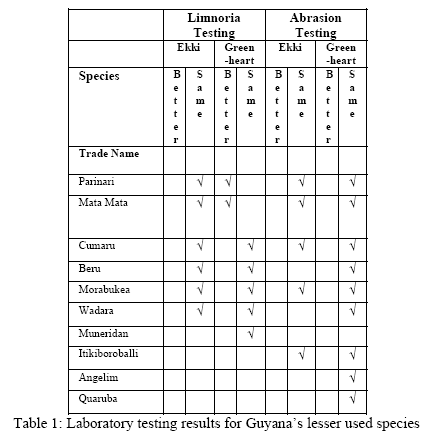
Tests on natural durability are expected shortly and will
further enhance the scientific base of these species and
inform potential end-use applications.

|